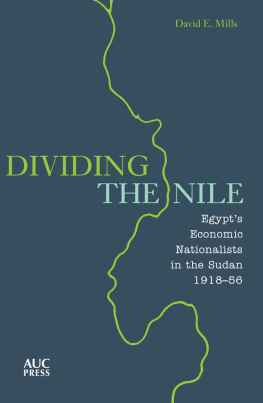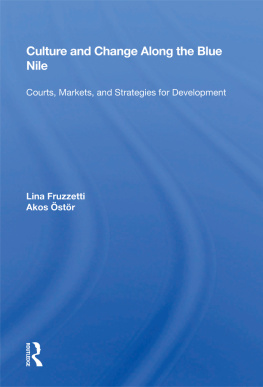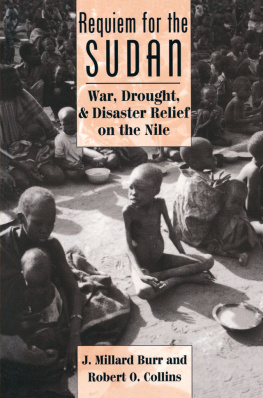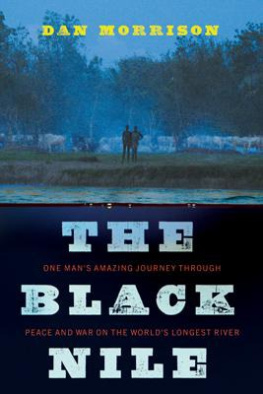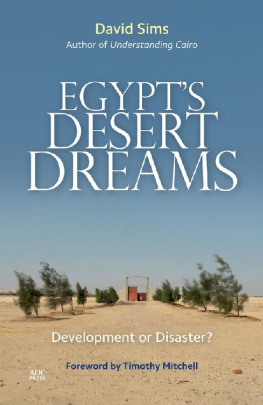DIVIDING
THE NILE
Egypts
Economic
Nationalists
in the Sudan
191856
David E. Mills
The American University in Cairo Press
Cairo New York
This electronic edition published in 2014 by
The American University in Cairo Press
113 Sharia Kasr el Aini, Cairo, Egypt
420 Fifth Avenue, New York, NY 10018
www.aucpress.com
Copyright 2014 by David E. Mills
All rights reserved. No part of this publication may be reproduced, stored in a retrieval system, or transmitted in any form or by any means, electronic, mechanical, photocopying, recording, or otherwise, without the prior written permission of the publisher.
ISBN 978 977 416 638 9
eISBN 978 161 797 619 3
Version 1
C ONTENTS
This book is dedicated
to the memory of my mother,
Jean Barbara Mills
This book is the product of many years of research and writing, during which time I have benefited tremendously from the assistance and encouragement of numerous family members, friends, and colleagues. I am certain to inadvertently omit some who aided me in the creation of this book, and I can only ask the forgiveness of those I forget to mention.
Unquestionably, the most instrumental scholarly guidance behind this work came from Dr. Byron Canon, who chaired my supervisory committee at the University of Utah. His roles as scholar, mentor, taskmaster, and friend were absolutely critical to my graduate studies, my research in Egypt, and my efforts to find employment in this field. Although I have tried over the years, I have never adequately expressed my appreciation for all Byrons efforts on my behalf. Additionally, Dr. Peter von Sivers and other members of my supervisory committee at Utah contributed tremendously to my scholarly progression. Finally, the financial and educational support of the University of Utahs Department of History and Middle East Center were vital to my work during this period.
Critical financial assistance for research conducted in Egypt was provided initially by a Fulbright doctoral dissertation research grant from the U.S. Department of Education and later through a research fellowship from the West Virginia Humanities Council. Thanking all those Egyptians who have assisted me over the years is well-nigh impossible. Instead of omitting some individuals, I would like to thank every scholar and staff member of the Binational Fulbright Commission of Egypt, the Institute of African Research and Studies at Cairo University, the American University in Cairo libraries, and, especially, the Egyptian National Archives and National Library. I would be remiss not to thank Dr. Muhammad Gamal al-Din al-Massady of Cairo University for his assistance in gaining access to various Egyptian archival repositories and introducing me to colleagues. Finally, the friendly advice and conversations with Alaa al-Din Arafat, Mine Ener, and many others made my work in Egypt so much more enjoyable.
Much of the writing and revising of this book has occurred over the past three to four years, with assistance from different sources. My colleague from Marshall Universitys Department of Geography, Dr. Jamie Leonard, was gracious enough to spend some of his valuable time creating the map included in this book. Many of my Department of History colleagues critiqued sections of this work, most notably Drs. David Kenley, Montserrat Miller, Dan Holbrook, and Kevin Barksdale. Furthermore, the critical comments of the anonymous readers were very much appreciated and instrumental in my revision process. Finally, the editors and staff of the American University in Cairo Press have been consistently helpful and a pleasure to work with on this project. I would like to express my gratitude especially to Nadia Naqib, Randi Danforth, and Johanna Baboukis. Your patience with my delays, questions, and communication difficulties has made the final stages of this publication a much easier process.
All of the individuals noted above have provided invaluable assistance in the completion of this project, but all responsibility for any errors, omissions, or other shortcomings of this book rests on my shoulders alone.
My familyPhil, Jean, Allison, and Alanhave always been supportive of my academic and professional pursuits, for which I am extremely thankful. Finally, my wife, Stephanie, and my son, Riley, will always have my deepest love and appreciation. They have had to endure my long nights of working on this book and have listened patiently over the years as I voiced my plans, difficulties, and concerns about this project.
The Nile and surrounding countries, 19181956
In 1955, Sudanese parliamentary leaders chose an independent existence for their country. Their decision disappointed many Egyptian nationalists who had been extolling the unity of the Nile Valley for decades. The Sudanese decision may have been the inevitable outcome of Britains efforts to isolate the Sudan since 1899, but there were other factors that critically inhibited unification. This study focuses on the economic initiatives of Egyptian nationalists, who sought to connect the Sudan and Egypt through commerce, investment, water sharing, infrastructural developments, and more. The study argues that Egyptian economic efforts in the Sudan were too little, too late, and constituted a missed opportunity reflective of a lack of political willpower. In other words, the lack of sustained economic contact between Egypt and the Sudan during the first half of the twentieth century confirmed broader trends that made the Egyptian dream of Nile Valley unity untenable.
The Sudanese ended Egyptian dreams of a unified nation in 1955, and scholars have traditionally taken two broad approaches in explaining why the Sudanese chose independence. One group of authors, including Peter Woodward, Heather Sharkey, Tim Niblock, and others, has described the path to independence through analysis of the composition and activities of local Sudanese leaders, political groupings, native officials, and the educated urban elite. Heather Sharkeys work is unique in its analysis of those Sudanese working within the Condominium administration and the dilemma they facedassisting in foreign control of their country, while also desiring to see it undone. The eventual Sudanese choice of a separate independent existence may have resulted from a history of Egyptian mistreatment or British encouragement of their independence, but these studies argue that it was ultimately the Sudanese who chose their future.
In contrast to those emphasizing Sudanese agency, scholars such as M.W. Daly, Gabriel Warburg, and Muddathir Abdel Rahim give much greater prominence to British and Egyptian activities, Condominium policies and personnel, or AngloEgyptian negotiations in deciding the Sudans fate. These studies do not entirely ignore the Sudanese, but emphasizing the centrality of external factors or actors in modern Sudanese history is only logical, considering that British and Egyptian officials largely denied the Sudanese any political role until the 1950s. Still, histories emphasizing Sudanese agency and those stressing external factors behind developments are not mutually exclusive.
However, what neither group includes in the history of eventual Sudanese independence is the role played by Egyptians. These scholars have not entirely omitted Egyptians, but typically the latter have more of a supporting role behind the true players in this historical dramathe British and Sudanese. Yes, Egyptians are part of negotiations, but they are only the irrational, stubborn diplomats attempting to subvert British-led Sudanese progress. Yes, they have been an actual physical presence in Sudanese history, but throughout this history they have uniformly viewed the Sudan as a colonial possession to be exploited to the fullest extent possible. Irrespective of how negativelyor notscholars have portrayed Egyptians, they have consistently treated them as definitively less influential actors in twentieth-century Sudanese history. Egyptians may have had a small role in the story of Sudanese independence, but efforts to unite the Nile Valley were a central component of the Egyptian nationalist movement.

